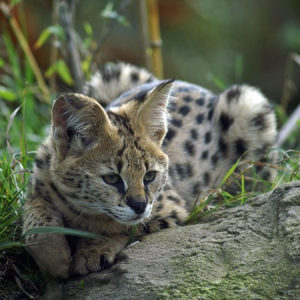Serval

Scientific Name: Leptailurus serval
IUCN (Red List) Status: Least Concern (LC)
.
With yellowish or orange coloured fur that is covered with both dark spots and stripes (the size and placement of which vary wildly between individuals), that helps to camouflage the Serval into the long grass. servals are slender, agile, and approximately 60 cm in length from shoulder to tail. Males weigh about 9 to 18 kg and females 9 to 13 kg. Their legs and ears are long and considered the largest in the cat family relative to their size.
Habitat: Forest, Savanna, Grassland, Wetlands (inland). he Serval has quite specific habitat requirements, so it may be locally restricted to smaller areas within its broad distribution range; it is not found in areas of rainforest or desert like habitats.. Servals are found in well-watered savanna long-grass environments and are particularly associated with reedbeds and other riparian vegetation types. Servals with well-watered habitats like grass savannas along river reed beds and swamps, in brush and open woodlands and along the edge of forests.. Servals can penetrate dense forest along waterways and through grassy patches, but are absent from the rainforests of Central Africa, and from desert environments.
Animal Location: Savannah Sanctuary
Diet: Serval specialize in preying on small mammals, in particular rodents, with birds of secondary importance, followed by reptiles and arthropods. Servals feed mainly on small mammals weighing in average ca 70 g and up to 1.5 kg, which mostly are nocturnal and have a preference for grassland, wetland or habitats associated with water; birds have an average weight of ca 250 g, in form of smaller birds (up to 200 g) or larger Galliformes (ground dwellers up to 4 kg).


